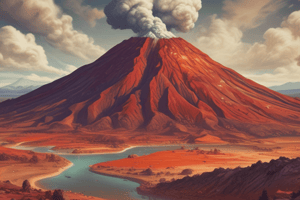Podcast
Questions and Answers
What is the primary reason for the formation of thick stubby lava flows in andesitic and rhyolitic lava?
What is the primary reason for the formation of thick stubby lava flows in andesitic and rhyolitic lava?
- High viscosity of the lava (correct)
- Low pressure in the volcanic vent
- High gas content in the magma
- Low viscosity of the lava
What is the characteristic feature of the surface of volcanic domes?
What is the characteristic feature of the surface of volcanic domes?
- Gently sloping with no spines
- Steeply inclined with no surface features
- Very rough with numerous spines (correct)
- Very smooth with few spines
What happens to the lava at the surface of a volcanic dome?
What happens to the lava at the surface of a volcanic dome?
- It piles up over the vent (correct)
- It cools and solidifies rapidly
- It mixes with water to form a mudflow
- It flows away from the vent
What is the primary factor that influences the formation of pyroclastic material?
What is the primary factor that influences the formation of pyroclastic material?
What is the term for hot, broken fragments of rock that are formed during explosive volcanic eruptions?
What is the term for hot, broken fragments of rock that are formed during explosive volcanic eruptions?
What is the term for loose assemblages of pyroclasts?
What is the term for loose assemblages of pyroclasts?
What is the term for pyroclasts with an average particle size greater than 64 mm?
What is the term for pyroclasts with an average particle size greater than 64 mm?
What happens to blocks of lava on the surface of a volcanic dome?
What happens to blocks of lava on the surface of a volcanic dome?
What is the characteristic shape of lava flows formed by andesitic and rhyolitic lava?
What is the characteristic shape of lava flows formed by andesitic and rhyolitic lava?
What is the primary difference between lava domes and lava flows?
What is the primary difference between lava domes and lava flows?




